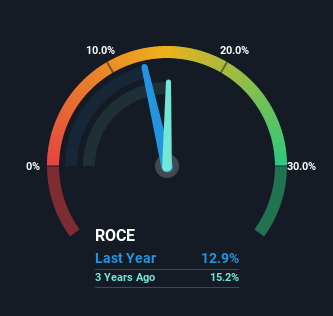- Israel
- /
- Energy Services
- /
- TASE:LAPD
Lapidoth Capital's (TLV:LAPD) Returns On Capital Not Reflecting Well On The Business
What are the early trends we should look for to identify a stock that could multiply in value over the long term? Firstly, we'd want to identify a growing return on capital employed (ROCE) and then alongside that, an ever-increasing base of capital employed. Basically this means that a company has profitable initiatives that it can continue to reinvest in, which is a trait of a compounding machine. However, after investigating Lapidoth Capital (TLV:LAPD), we don't think it's current trends fit the mold of a multi-bagger.
What Is Return On Capital Employed (ROCE)?
If you haven't worked with ROCE before, it measures the 'return' (pre-tax profit) a company generates from capital employed in its business. To calculate this metric for Lapidoth Capital, this is the formula:
Return on Capital Employed = Earnings Before Interest and Tax (EBIT) ÷ (Total Assets - Current Liabilities)
0.13 = ₪533m ÷ (₪7.6b - ₪3.5b) (Based on the trailing twelve months to September 2022).
Thus, Lapidoth Capital has an ROCE of 13%. On its own, that's a standard return, however it's much better than the 5.8% generated by the Energy Services industry.
Check out our latest analysis for Lapidoth Capital

Historical performance is a great place to start when researching a stock so above you can see the gauge for Lapidoth Capital's ROCE against it's prior returns. If you'd like to look at how Lapidoth Capital has performed in the past in other metrics, you can view this free graph of past earnings, revenue and cash flow.
What Does the ROCE Trend For Lapidoth Capital Tell Us?
We weren't thrilled with the trend because Lapidoth Capital's ROCE has reduced by 41% over the last five years, while the business employed 541% more capital. However, some of the increase in capital employed could be attributed to the recent capital raising that's been completed prior to their latest reporting period, so keep that in mind when looking at the ROCE decrease. The funds raised likely haven't been put to work yet so it's worth watching what happens in the future with Lapidoth Capital's earnings and if they change as a result from the capital raise.
While on the subject, we noticed that the ratio of current liabilities to total assets has risen to 46%, which has impacted the ROCE. Without this increase, it's likely that ROCE would be even lower than 13%. What this means is that in reality, a rather large portion of the business is being funded by the likes of the company's suppliers or short-term creditors, which can bring some risks of its own.
The Bottom Line On Lapidoth Capital's ROCE
To conclude, we've found that Lapidoth Capital is reinvesting in the business, but returns have been falling. Investors must think there's better things to come because the stock has knocked it out of the park, delivering a 407% gain to shareholders who have held over the last five years. But if the trajectory of these underlying trends continue, we think the likelihood of it being a multi-bagger from here isn't high.
One more thing to note, we've identified 1 warning sign with Lapidoth Capital and understanding this should be part of your investment process.
For those who like to invest in solid companies, check out this free list of companies with solid balance sheets and high returns on equity.
New: AI Stock Screener & Alerts
Our new AI Stock Screener scans the market every day to uncover opportunities.
• Dividend Powerhouses (3%+ Yield)
• Undervalued Small Caps with Insider Buying
• High growth Tech and AI Companies
Or build your own from over 50 metrics.
Have feedback on this article? Concerned about the content? Get in touch with us directly. Alternatively, email editorial-team (at) simplywallst.com.
This article by Simply Wall St is general in nature. We provide commentary based on historical data and analyst forecasts only using an unbiased methodology and our articles are not intended to be financial advice. It does not constitute a recommendation to buy or sell any stock, and does not take account of your objectives, or your financial situation. We aim to bring you long-term focused analysis driven by fundamental data. Note that our analysis may not factor in the latest price-sensitive company announcements or qualitative material. Simply Wall St has no position in any stocks mentioned.
About TASE:LAPD
Lapidoth Capital
Provides drilling and related services in Israel, Romania, the United States, Poland, rest of Europe, and internationally.
Excellent balance sheet with proven track record.
Market Insights
Community Narratives



